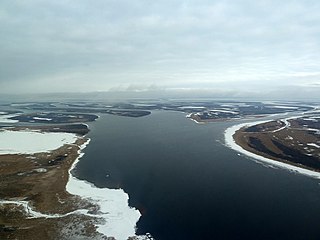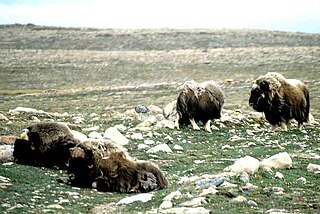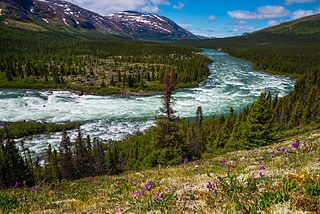
Alpine tundra is a type of natural region or biome that does not contain trees because it is at high elevation, with an associated harsh climate. As the latitude of a location approaches the poles, the threshold elevation for alpine tundra gets lower until it reaches sea level, and alpine tundra merges with polar tundra.

The Baffin coastal tundra is a small ecoregion of the far north of North America, on the central north coast of Baffin Island in the Canadian territory of Nunavut. This is permafrost tundra with an average annual temperature below freezing.

Nenets Nature Reserve is a Russian 'zapovednik' in the northeast of European Russia on the coast of the Barents Sea and the delta of the Pechora River, about 800 km northeast of Arkhangelsk. With abundant wetlands, rivers, and sea islands, the reserve is an important point on the Atlantic migratory path for birds that winter in Western Europe and nest in the Eastern Europe and Western Siberian Tundra. Also present are large breeding grounds for the Atlantic Walrus. The reserve is situated in the Zapolyarny District of Nenets Autonomous Okrug. It was formally established in 1997, and covers and area of 313,400 ha (1,210 sq mi), of which 181,000 ha (700 sq mi) is over water.

The Arctic desert ecoregion is a terrestrial ecoregion that covers the island groups of Svalbard, Franz Josef Land, Severny Island and Severnaya Zemlya in the Arctic Ocean, above 75 degrees north latitude. The region is covered with glaciers, snow, and bare rock in a harshly cold environment. The temperature does rise above freezing for short periods in the summer, so some ice melt occurs, and the area supports colonies of sea birds and mammals. It has an area of 161,400 square kilometres (62,300 sq mi).

The Bering tundra ecoregion is an ecoregion that covers a portion of northeastern Russia, between the Kolyma Mountains on the west, and the Bering Sea coast to the east. The area is an important stopping place for migratory birds. It has an area of 474,227 square kilometres (183,100 sq mi).

The Cherskii–Kolyma mountain tundra ecoregion is an ecoregion that covers the higher elevations of the Chersky Range and the Kolyma Mountains, the only large mountain range in northern Russia. It is in the Palearctic realm, and tundra biome. It has an area of 556,589 square kilometres (214,900 sq mi).

The Chukchi Peninsula tundra ecoregion is an ecoregion that covers the northern coast of Russia along the East Siberian Sea, a marginal sea of the Arctic Ocean. The climate is somewhat milder than would be expected for its latitude, but the moderating effects of the East Siberian Sea and Bering Sea permits summer daytime temperatures above 50 °F (10 °C). Many colonies of migrating birds visit the area. The ecoregion is in the Palearctic realm, and tundra biome. It has an area of 298,367 square kilometres (115,200 sq mi).

The Kamchatka Mountain tundra and forest tundra ecoregion is an ecoregion that covers the central mountain range of the Kamchatka Peninsula in the Russian Far East. The region is one of volcanos, caldera, geysers, and mountain tundra. It is in the Palearctic realm and tundra biome. It has an area of 119,400 square kilometres (46,100 sq mi).

The Northeast Siberian coastal tundra ecoregion is an ecoregion that covers the coastal plain of the central north region of Siberia in Russia. This coastal region borders the Laptev Sea and the East Siberian Sea, both marginal seas of the Arctic Ocean, from the Lena River delta in the west to the Kolyma River delta in the east. There are several large river deltas in the area that support breeding grounds for 60 to 80 species of migratory birds. The region is in the Palearctic realm, and the tundra biome. It has an area of 846,149 square kilometres (326,700 sq mi).

The Northwest Russian-Novaya Zemlya tundra ecoregion is an ecoregion on the north coast of European Russia. It covers the southern shores of the White Sea, the coast of the Barents Sea east to the Yamal Peninsula, the southern half of Novaya Zemlya, and numerous inlets and islands. The low tundra wetlands are important breeding grounds for waterfowl. The ecoregion is in the Palearctic realm, and the tundra biome. It has an area of 284,122 square kilometres (109,700 sq mi).

The Taimyr-Central Siberian tundra ecoregion is an ecoregion that broadly covers the Taymyr Peninsula in the Russian Far North. It ranges from the delta of the Yenisei River in the west, across the Taymyr Peninsula and Khatanga Gulf, to the Lena River delta in the east. The region is an important area for breeding birds. It is in the Palearctic realm in the tundra biome, and is mostly located in Taymyrsky Dolgano-Nenetsky District of Krasnoyarsk Krai. It has an area of 954,670 square kilometres (368,600 sq mi).

The Trans-Baikal Bald Mountain tundra ecoregion covers the high-altitude peak zones above the treeline in a series of mountain ranges that stretch from the northern reaches of Lake Baikal to the western coastal ranges of the Okhotsk Sea. Floral communities are those of mountain tundra, with bare rock or permafrost under layers of moss and lichen. Because the ecoregion is aligned along a common latitude, it acts as a route for the transmission of species across Siberia. The ecoregion is in the Palearctic realm and the tundra biome. It has an area of 217,559 square kilometres (84,000 sq mi).

The Yamal–Gydan tundra ecoregion is an ecoregion that covers the Yamal Peninsula and Gydan Peninsula in northern Russia. Plants and animals are sparse, although the area is an important one for migratory birds, and for coastal sea mammals. The ecoregion is in the Palearctic realm, and the tundra biome. It has an area of 412,067 square kilometres (159,100 sq mi).

Pacific Coastal Mountain icefields and tundra is a tundra ecoregion in Alaska, British Columbia, and Yukon, as defined by the World Wildlife Fund (WWF) categorization system.

The Davis Highlands tundra ecoregion covers the Baffin Mountains on the northeast coast of Baffin Island and Bylot Island, facing Baffin Bay in Nunavut, northern Canada. The terrain is extremely rugged, heavily glaciated, with many deep fjords, and very cold. About half of the territory is moss and lichen tundra, the other half bare rock and ice. The region is wetter than the much drier regions to the southwest of the Baffin Islands.

The Kalaallit Nunaat high arctic tundra ecoregion covers the coastal areas of northern and eastern Greenland. Areas inland of this strip of land are either covered in ice or bare rock. About one-third of the region is covered by mosses and lichens, and another 3% by herbaceous vegetation and shrubs. The largest national park in the world, Northeast Greenland National Park, protects a majority of the land within the ecoregion.

The Kalaallit Nunaat low arctic tundra ecoregion covers the low coastal areas of western and southern Greenland, reaching in up to 100 km before bare rock and ice become dominant. While much of the ecoregion is bare rock or ice, about 50% of the ground is covered in moss and lichen, and another 10% in herbaceous cover, shrubs, and even small stands of trees.

The Middle Arctic tundra ecoregion covers a broad stretch of northern Canada - the southern islands of the Arctic Archipelago, plus the northern mainland of Nunavut and, across Hudson Bay to the east, a portion of northern Quebec. This is the coldest and driest ecoregion in Canada, and can be referred to as a 'polar desert'. It is an important region for breeding and migratory birds, and supports 80% of the world's muskox.

The Torngat Mountain tundra ecoregion covers the Torngat Mountains on the northeastern tip of the Labrador Peninsula where the provinces of Quebec and Newfoundland and Labrador meet. The mountains feature glacially carved U-shaped valleys and deep fjords. The vegetation over most of the territory is that of arctic tundra, herbaceous cover, or bare rock. The region supports seasonal polar bears, black bears, and caribou. The Atlantic coast is on the Atlantic Flyway for migratory birds.

Khibiny National Park protects a mountainous region of taiga and tundra on the Khibiny Mountains and Lovozero Massif of the western Kola Peninsula in northwestern Russia. The mountains contain commercially important minerals, and the park's borders reflect the need to balance three uses - protection of the unique natural environment, recreation, and industrial mining. The park was officially created in 2018, and is located in the districts of Kirovsk and Olenegorsk in Murmansk Oblast.





















